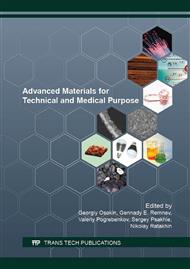p.273
p.277
p.282
p.288
p.295
p.303
p.308
p.313
p.319
Study of Hematite Mineral Samples in Purification of Aqueous Solutions from As3+ and Fe3+ Ions
Abstract:
Hematite mineral samples of Korshunov deposit were the subject of the study. The samples size was less than 0.1 mm; 0.5-1 mm and 1.5-2.5 mm. Some physicochemical properties of adsorbent samples were investigated: specific surface and specific pore volume were identified; zeta potential was measured; thermal and elemental analyses were carried out. Sorption properties of samples obtained under static conditions were studied. They were investigated in removing Fe3+ and As3+ ions from simulated solutions. Content analysis of the ions in filtrates was carried out by stripping voltamperometry and photocolorimetry methods. In using hematite, removal of As+3 ions from the solution increases if adsorption time increases. The smaller grain size, the better purification of simulated solution was. Hematite with the size of particles less than 0.1 mm is more effective in removing of Fe+3 ions from solution, if contact time is short. It has been found that if contact time is longer, hematite with 0.5-1 mm and 1.5-2.5 mm sizes of particles is better to use. The authors have concluded that hematite can be used for efficient water purification from iron ions and arsenic ions
Info:
Periodical:
Pages:
295-300
Citation:
Online since:
September 2016
Price:
Сopyright:
© 2016 Trans Tech Publications Ltd. All Rights Reserved
Share:
Citation:


